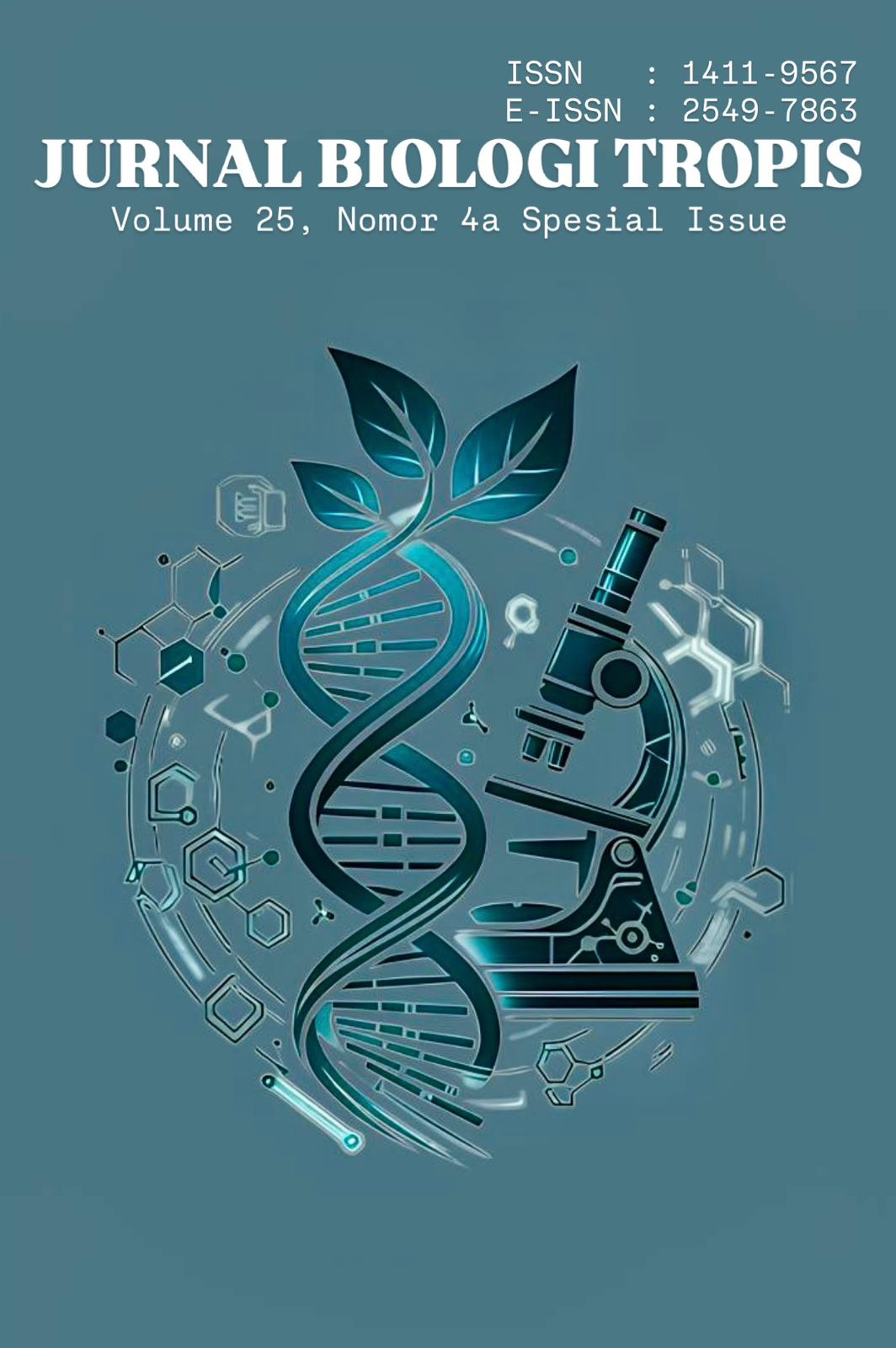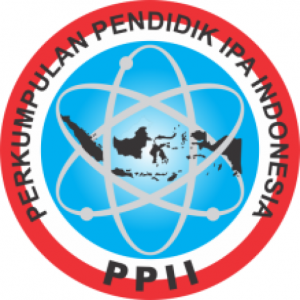Toxicity Test of Methanol Extract of Neem (Azadirachta indica) Leaves on Instar III Larvae (Bactrocera spp)
Authors
Sundus Sepia Almaheran , I Putu Artayasa , Syamsul BahriDOI:
10.29303/jbt.v25i4a.10626Published:
2025-10-04Issue:
Vol. 25 No. 4a (2025): Special IssueKeywords:
Azadirachtin, Bactrocera spp, Botanical insecticide, Neem leaf extract, Natural pesticide, Fruit fly larvae, Starfruit, Larvicidal activity, Secondary metabolitesArticles
Downloads
How to Cite
Downloads
Metrics
Abstract
Azadirachtin, alkaloids, saponins, tannins, and flavonoids are some of the secondary metabolites found in neem leaves. These compounds have natural insecticidal activity and function as antifeedants or repellents to effectively inhibit the growth and development of insect pests. This study investigates the effects of neem leaf extract (Azadirachta indica) as a natural pesticide on the mortality of fruit fly larvae (Bactrocera spp.) found in starfruit (Averrhoa carambola L.). We conducted experiments using various concentrations of neem leaf extract: 0%, 4%, 9%, 14%, 17%, and 19%. The fruit fly larvae were treated with the extract for 6 hours, and the mortality rates were subsequently observed. The results demonstrated a positive correlation between increasing concentrations of neem extract and higher larval mortality rates. The highest concentration of 19% resulted in a mortality rate of 95%. One-Way ANOVA statistical analysis showed a significant effect of the extract on larval mortality (p < 0.05). The Tukey HSD test revealed significant differences in mortality rates between concentrations of 9% and above when compared to the control and lower concentrations. The LC50 value was calculated at 15.263%, indicating that neem leaf extract is effective as a larvicide. Neem leaf extract contains secondary metabolites such as azadirachtin, alkaloids, saponins, tannins, and flavonoids, which likely induce larval death through morphological damage to the digestive organs and head. This study concludes that neem leaf extract is a promising botanical pesticide for controlling fruit fly pests in starfruit.
References
Aini, K., Elfita, E., Widjajanti, H., Setiawan, A., & Oktiansyah, R. (2020). Bioactivity of secondary metabolite of endophytic fungi extract isolated from root of Jambu Mawar (Syzygium jambos). International Journal of Secondary Metabolite, 12(1), 16-32.
Akhmad, R. (2022). Pengaruh ketinggian lokasi tumbuh terhadap kadar total Flavonoid dan daya antioksidan daun kirinyuh (Chromolaena odorata (l.) RM King & H. Rob) (Doctoral dissertation, Universitas Islam Negeri Maulana Malik Ibrahim).
Alfiani, R. (2024). UJI Efektivitas Biopestisida Ekstrak Daun Mimba (Azadirachta Indica Juss.) Terhadap Hama Penggerek (Hypothenemus hampei) PADA KOPI ROBUSTA (Coffea canephora) (Doctoral dissertation, universitas jambi).
Awaluddin, R., Sholihatin, B., Marfu’ah, N., & Estikomah, S. A. (2021). Aktivitas Larvasida Fraksi N-Heksan Ekstrak Etanol Daun Mengkudu (Morinda citrifolia. L) terhadap Larva Aedes sp.: Larvicide Activity of N-Hexane Fraction of Ethanolic Morinda citrifolia. L Leaves Extract on Aedes sp. Larvae. ASPIRATOR-Journal of Vector-Borne Diseases Studies, 13(2), 137-146.
Bahri, S., Zulkifli, L., Rasmi, D. A. C., & Sedijani, P. (2021). Isolation, Purification, and Toxicity Test of Bacillus thuringiensis from Cows Cage Soil Againts Drosophila melanogaster. Jurnal Biologi Tropis, 21(3), 1106-1114. https://jurnalfkip.unram.ac.id/index.php/JBT/article/view/3221
Basundari, S. A., Tarwotjo, U., & Kusdiyantini, E. (2018). Pengaruh kandungan ekstrak daun zodia (Evodia suaveolens) terhadap mortalitas larva nyamuk Aedes aegypti. Bioma: Berkala Ilmiah Biologi, 20(1), 51-58.
Cania, B. E. dan E. Setyaningrum. 2013. Uji efektifitas larvasida ekstrak daun legundi (Vitex trifolia) terhadap mortalitas larva Aedes aegypti. Medical Journal of Lampung University, 2(4), 53-60.
de Souza Wuillda, A. C. J., Campos Martins, R. C., & Costa, F. D. N. (2019). Larvicidal activity of secondary plant metabolites in aedes aegypti control: An overview of the previous 6 years. Juran Natural Product Communications, 14(7), 1934578X19862893.
Fajrina, A., Bakhtra, D. D. A., Eriadi, A., Putri, W. C., & Wahyuni, S. (2021). Uji aktivitas antibakteri ekstrak etanol rambut jagung (Zea mays L.) terhadap bakteri Streptococcus mutans dan Porphyromonas gingivalis. Jurnal Farmasi Higea, 13(2), 155-164.
Farid, Z. (2021). Pengaruh Pemakaian Tepung Daun Pepaya (Carica Papaya L) Dalam Ransum Ayam Broiler Terhadap Intake Energi, Intake Protein Dan Rasio Efisiensi Protein (Doctoral dissertation, Universitas Andalas).
Firdaus, F. A., Astriani, D., & Dinarto, W. (2024). Effect Of Concentration Of Neem Leaves Botanical Pesticide On Pest Management In Red Chili Pepper: Pengaruh Konsentrasi Pestisida Nabati Daun Mimba Terhadap Pengelolaan Hama Pada Cabai Merah. Jiga: Journal Innovation in Green Agriculture, 1(2), 90-98. https://ejurnal.mercubuana-yogya.ac.id/index.php/JIGA/article/view/4293
Herlinda, S., Mayasari, R., Adam, T., & Pujiastuti, Y. (2007, June). Populasi dan serangan lalat buah Bactrocera dorsalis (Hendel) (Diptera: Tephritidae) serta potensi parasitoidnya pada pertanaman cabai (Capsicum annuum L.). In Seminar Nasional dan Kongres Ilmu Pengetahuan Wilayah Barat, Palembang (pp. 3-5).
Hotimah, O., Wirutomo, P., & Alikodra, H. S. (2015). Conservation of world heritage botanical garden in an environmentally friendly city. Procedia Environmental Sciences, 28, 453-463.
Juanda, J., & Jayadi, E. M. (2015). Pengaruh Ekstrak Daun Mimba (Azadirachta indica A. Juss) Terhadap Mortalitas Hama Lalat Buah Cabai (Bactrocera dorsalis L.). Biota, 8(1), 97-106.
Kartikasari, D., & Novitasari, M. (2018). Uji Aktivitas Larvasida Perasan Herba Seledri (Apium graveolens L.) Terhadap Larva Aedes aegypti. Jurnal Ilmiah As-Syifaa, 10(2), 152-160.
Killa, Y. M., Maranda, A. P., & Hana, M. R. (2023). Efektivitas Pestisida Nabati Ekstrak Daun Mimba (Azadirachta Indica) Dan Srikaya (Annona Squamosa Linn) Untuk Mengendalikan Hama Belalang Kembara (Locusta Migratiria Minilensis Mayen). Jurnal Agro Wiralodra, 6(1), 9-13.
Kurnia, R. T., Artayasa, I. P., lhamdi, M. L., Yamin, M. (2023). Comparison of Bactrocera Fruit Fly Captures Using Basil and Celery Leaf Extracts in Karang Bayan Plantation. Jurnal Biologi Tropis, 23 (2), 517-525.
Lestari, A. P. A., Artayasa, I. P., & Sedijani, P. (2020). Ethanol extract of pseudo-stem lemongrass (Cymbopogon citrates) and basil leaves (Ocimum sanctum) increase bactrocera (Diptera: Tephritidae) fruit fly catches. Jurnal Biologi Tropis, 20(3), 369-377. https://jurnalfkip.unram.ac.id/index.php/JBT/article/view/2070.
Lestari, I. (2023). Efektivitas Ekstrak Daun Sirih (Piper Betle, Linn) Sebagai Larvasida Pada Larva Nyamuk Aedes aegypti (Doctoral dissertation, Poltekkes Kemenkes Tanjung Karang).
Lina, E. C., Supriadi, A., Yunisman, Y., & Martinius, M. (2017). Aktivitas insektisida campuran ekstrak air buah Piper aduncum L.(Piperaceae) dan batang Cymbopogon ciratrus (Dc.) Stapf (Poaceae) terhadap larva Crocidolomia pavonana F.(Lepidoptera: Crambidae). Jurnal Proteksi Tanaman (Journal of Plant Protection), 1(1), 34-41.
Lisnayani, L. (2021). Pengaruh Ukuran Pemotongan Dan Perendaman Menggunakan Larutan Garam Terhadap Kandungan Tanin, Serat Kasar Serta Protein Kasar Kulit Pisang Tanduk (Musa acuminate var. Typica) (Doctoral dissertation, Universitas Hasanuddin).
Liu, M., Feng, J., Shen, Y., & Zhu, B. (2023). Microplastics effects on soil biota are dependent on their properties: A meta-analysis. Soil Biology and Biochemistry, 178, 108940.
Madjid, A., Hidayat, E., & Susilawati, N. (2017). The Trend of Conflict in Indonesia 2016. PEOPLE: International Journal of Social Sciences, 3(3), 268-279. https://pdfs.semanticscholar.org/658c/a669176c88f6efcafbfc138c0ebc116b2197.pdf
Mulyani, H. S. (2020). Pengaruh Perendaman Ekstrak Daun Kersen (Muntingia Calabura) Dengan Dosis Berbeda Terhadap Lama Inkubasi, Daya Tetas Dan Kelulushidupan Larva Ikan Lele Dumbo (Clarias Gariepinus) (Doctoral dissertation, Universitas Islam Riau).
Muta’ali, R., & Purwani, K. I. (2015). Pengaruh ekstrak daun beluntas (Pluchea indica) terhadap mortalitas dan perkembangan larva Spodoptera litura F. Jurnal Sains dan Seni ITS, 4(2), 55-58.
Nebesski, D. (2023). Efektivitas Ekstrak Daun Binahong (Anredera Cordifolia) Sebagai Biolarvasida Pada Larva Aedes Aegypti Instar Iii (Doctoral dissertation, Poltekkes Kemenkes Tanjung Karang).
Olivoto, T., Nardino, M., Carvalho, I. R., Follmann, D. N., Szareski, V. J., Ferrari, M., ... & de Souza, V. Q. (2017). Plant secondary metabolites and its dynamical systems of induction in response to environmental factors: A review. African Journal of Agricultural Research, 12(2), 71-84.
Putri, E. (2019). Uji efektivitas ekstrak daun pandan wangi (pandanus amaryllifolius roxb) sebagai insektisida terhadap lalat rumah (musca domestica). Universitas Islam Negeri Alauddin Makassar, 1.
Putri, K. A. (2019). Infestasi Lalat Buah (Bactrocera spp.) Pada Buah Jambu Air Madu (Syzygium samarangense) di Sumatera Utara. Jurnal Jeumpa, 6(2), 236-244. https://ejurnalunsam.id/index.php/jempa/article/view/2097
Rattan, R. S. (2010). Mechanism of action of insecticidal secondary metabolites of plant origin. Jurnal Crop protection, 29(9), 913-920.
Roopashree, K. M., & Naik, D. (2019). Saponins: properties, applications and as insecticides: a review. Juranal Biosci. Trends, 8(1), 1-14.
Sartika, W. D., Ginting, S. B., & Afriyanto, D. (2022, December). Distribusi Lalat Buah Bactrosera sp,(Diptera: Tephritidae) Pada Buah Jambu Biji di Kota Bengkulu. In Prosiding Seminar Nasional Perlindungan Tanaman (Vol. 1, pp. 128-144).
Semwal, D. K., Semwal, R. B., Combrinck, S., & Viljoen, A. (2016). Myricetin: A dietary molecule with diverse biological activities. Nutrients, 8(2), 90.
Shofa, W. N. (2021). Pengaruh ekstrak daun mimba (Azadirachta indica), daun sirsak (Annona muricata), dan kombinasi keduanya sebagai insektisida nabati terhadap ulat grayak (Spodoptera litura F.) (Doctoral dissertation, Universitas Islam Negeri Maulana Malik Ibrahim). http://etheses.uin-malang.ac.id/32125/
Sinambela, B. R. (2024). Dampak Penggunaan Pestisida Dalam Kegiatan Pertanian Terhadap Lingkungan Hidup dan Kesehatan. Jurnal Agrotek, 8 (1), 76-85.
Singh, A. P., & Savaldi-Goldstein, S. (2015). Growth control: brassinosteroid activity gets context. Journal of experimental botany, 66(4), 1123-1132.
Sucitra, Y., Bahri, S., & Artayasa, I. P. (2022). The effect of lemongrass stem (Cymbopogon citratus) and salam leaves (Syzygium polyanthum) ethanol extracts on the number of bactrocera fruit flies catches. Jurnal Biologi Tropis, 22(1), 289-296. https://jurnalfkip.unram.ac.id/index.php/JBT/article/view/3237/0
Sumihe, G., Runtuwene, M. R., & Rorong, J. A. (2014). Analisis fitokimia dan penentuan nilai LC50 ekstrak metanol daun liwas. Jurnal Ilmiah Sains, 125-128.
Supriatna, J. (Ed.). (2023). Biologi Terapan untuk Masa Depan dan Kemajuan Bangsa. Yayasan Pustaka Obor Indonesia.
Wahyudi, R., Harfina, H., & Khoirul Abror, Y. (2021). The Effect Of Corn Silk Extract (Zea Mays) As Biolarvicides Of Aedes Aegypti Mosquito Larvae In Efforts To Control Spread Of Dengue Hemorrhagic Fever. The Indonesian Journal, 16(1), 23-31.
Wulansari, R. (2022). Analisis senyawa metabolit sekunder dan uji aktivitas larvasida alami pada ekstrak etanol daun bidara (Ziziphus mauritiana Lamk.) terhadap larva Aedes aegypti (Doctoral dissertation, Universitas Islam Negeri Maulana Malik Ibrahim). http://etheses.uin-malang.ac.id/37336/
License
Copyright (c) 2025 Sundus Sepia Almaheran, I Putu Artayasa, Syamsul Bahri

This work is licensed under a Creative Commons Attribution 4.0 International License.

Jurnal Biologi Tropis is licensed under a Creative Commons Attribution 4.0 International License.
The copyright of the received article shall be assigned to the author as the owner of the paper. The intended copyright includes the right to publish the article in various forms (including reprints). The journal maintains the publishing rights to the published articles.
Authors are permitted to disseminate published articles by sharing the link/DOI of the article at the journal. Authors are allowed to use their articles for any legal purposes deemed necessary without written permission from the journal with an acknowledgment of initial publication to this journal.


























